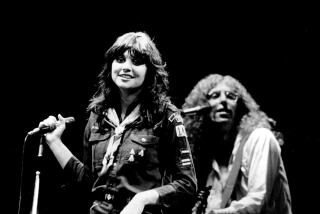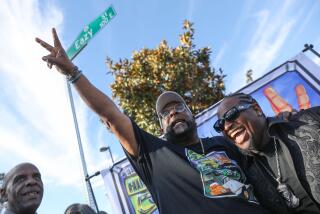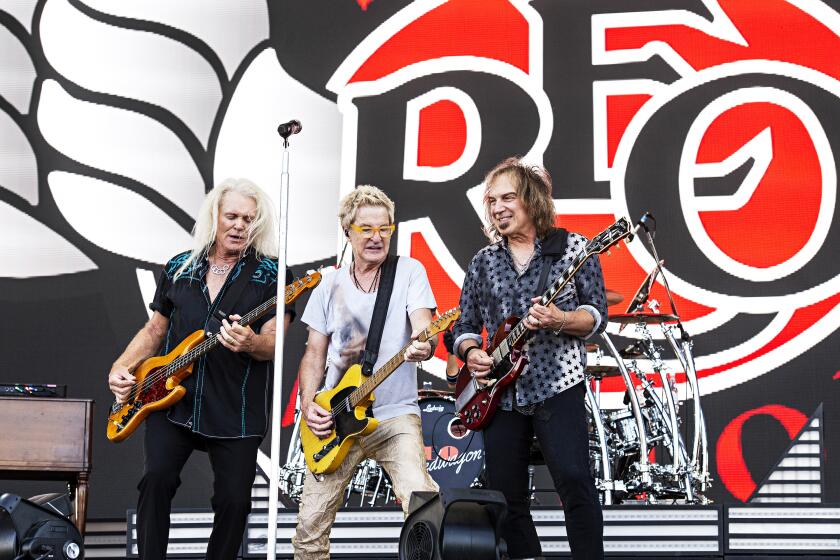‘Little Jazz’ Left His Mark as a Giant
When Roy (Little Jazz) Eldridge died on Sunday, it was obvious, whatever the official cause of death, that he was the victim of a broken heart. His wife of 53 years, Viola, had recently died, and Eldridge, 78, felt he had nothing to live for. (In a bizarre coincidence, Eldridge’s cousin Reunald Jones Sr. also died Sunday in Los Angeles. He, too, was 78 and played trumpet in many name bands.)
Eldridge had been forced to put down his trumpet forever after suffering a stroke in 1980, and had been seen publicly since then only in occasional appearances singing and playing drums.
My first exposure to Eldridge was a magical evening in 1936 at Harlem’s Savoy Ballroom; he was with Teddy Hill’s memorable band, with saxophonist “Chu” Berry as the other principal soloist.
Because Eldridge was unknown then, having made almost no records, his unique, searing sound and impassioned style came as a revelation. After he and Berry joined the Fletcher Henderson Orchestra he began to achieve recognition as the first major trumpet influence since Louis Armstrong.
In Chicago, in 1938, Roy played at the Three Deuces with an incredible small band. Art Tatum was at the piano; John Collins was the guitarist, Zutty Singleton the drummer. This was Swing era combo music at its supreme level.
In May, 1940, Milt Gabler and I produced a session for Commodore Records with Eldridge, Benny Carter and Coleman Hawkins in the front line. Roy’s solos in this intimate setting became classics that have been reissued time and again.
He played alongside Louis Armstrong for their first joint appearance in the Esquire Allstars concert at the Metropolitan Opera House. Roy’s disposition always seemed happy and outgoing; it was not until after his later experiences with Jim Crow that bitterness surfaced.
He was the only black musician in Gene Krupa’s band from 1941-43, one of several blacks in an all-star band on Mildred Bailey’s CBS radio series in 1943-44, then became the only black with Artie Shaw’s band in 1945.
After he left Shaw he told me of his humiliating experiences.
“As long as I’m in America,” he said, “I’ll never work in a white band again! It all goes back to when I joined Gene Krupa. It thrilled me to be accepted as a regular member of the band, but I knew that all eyes were on me to see if I’d do anything wrong.
“All the guys in the band were nice, Gene especially. Then we headed for California and the trouble began. We arrive in one town and the rest of the band checks in. I can’t get into their hotel, so I keep my bags and start looking for another place. I get to where someone is supposed to have made a reservation for me; then the clerk sees me, suddenly discovers that a regular tenant just arrived and took the last available room. I lug my dozen pieces of luggage back onto the street and start looking again.
“By the time that kind of thing has happened night after night, it begins to work on my mind; I can’t think right, I can’t play right. When we finally got to the Palladium in Hollywood, I had to watch who I could sit at tables with. If they were movie stars who wanted me to come over, that was all right; if they were just the jitterbugs, no dice. And all the time the bouncer with his eye on me, just watching for a chance. . . .
“I had to live way out in Los Angeles, while the rest of the guys stayed in Hollywood. It was a lonely life. One night the tension got so bad I flipped. I started trembling, ran off the stand and threw up. They carried me to the doctor’s. I had 105 (degree) fever; my nerves were shot.
“When I went back a few nights later, I heard that people had been asking for their money back because they couldn’t hear ‘Let Me Off Uptown.’ This time they let me sit at the bar.
“Later on, when I was with Artie Shaw, I went to a dance date and they wouldn’t even let me in the place. ‘This is a white dance,’ they said, and there was my name right outside. I told them who I was. When I finally did get in, I played that first set, trying to keep from crying. By the time I got through the set, the tears were rolling down my cheeks. I went up to a dressing room and stood in a corner crying and saying to myself why the hell did I come out here again when I knew what would happen.
“Artie came in and he was real great. He made the guy apologize that wouldn’t let me in, and got him fired.
“Man, when you’re on the stage, you’re great, but as soon as you come off, you’re nothing. It’s not worth the glory, not worth the money, not worth anything. Never again!”
Happily, Eldridge did not have to live up to his resolution. Conditions improved a little, and by 1949 he was back in the Krupa band. The following year he worked with Benny Goodman, touring Europe, then stayed on the Continent playing with everyone from Sidney Bechet to Charlie Parker and recording, among other things, a delightful blues vocal in French, “Tu Disais Que Tu m’Aimais.”
Much of the rest of his playing career was with mixed bands, most notably on tour with Norman Granz’s Jazz at the Philharmonic (named for Los Angeles’ Philharmonic Auditorium). He also co-led a quintet with Coleman Hawkins.
Roy Eldridge was to the evolution of jazz trumpet in the 1930s and early ‘40s what Armstrong had been in the ‘20s, and what Dizzy Gillespie would be from the mid-’40s, what Miles Davis would be in the ‘50s. He recorded with everyone from Art Tatum and Harry (Sweets) Edison and Oscar Peterson and Bud Freeman, with a string ensemble with a Dixieland band.
How it must have rankled him, during those last eight years when playing was forbidden to him, to see so many avenues opening up. What a joy it would have been to share his company, and his sound, at the jazz parties and on the jazz cruises. The last time we talked, a year ago, he sounded as cheerful as ever. If he was laughing on the outside and still crying on the inside, he did a magnificent job of concealing it.
Ave atque vale, Little Jazz.
More to Read
The biggest entertainment stories
Get our big stories about Hollywood, film, television, music, arts, culture and more right in your inbox as soon as they publish.
You may occasionally receive promotional content from the Los Angeles Times.










